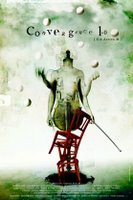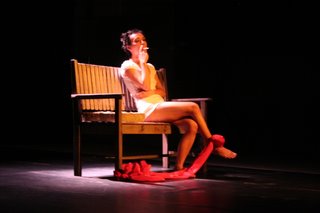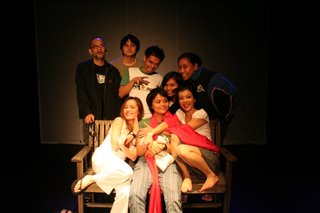[The trouble with love-at-first-sight encounters is it’s hasty gesticulation to risk almost near admission of indeterminacy complimented by an infallible cortical rush that soon domesticates to an anticipation of failure dressed up ready for the next evening's party. Failure definitely sounds sexy. More so when the manicured completeness of the landscape has slowly become unbearable, when grunge is making a miscalculated comeback, when plaid and paisley is the new black, when those teenagers two decades back deliberately slashed jeans as cool, when the body is withoutorgans, when void and empty is comforting, when thick descriptions of the boring occupy endless pages of a manuscript repeatedly rejected and indefinitely postponed, when punctuation has been overused because the exotic has finally refined the appearance of a cosmopolitan global citizen.]
Here (1) failure is repackaged as the necessary x to sustain the tension that binds. A (2) failure that is symbolic of the obtuse of stability, (3) like those preemptive gestures that allay the fear of the impossible. (4) Failure provides the possibility to keep the phantasm of the ideal intact and tedium of habit admissible. (5) Failure allocates space for permutations and peripheral investigations. (6) Failure poses as motivation to reframe the ordinary and organization of the world as we observe it. (7) A failure that is at the same time a concealment of the tendency to manufacture eloquent excuses to prolong indecision and disclosure. (8) Failure is fragment consummate, an oblique strategy that is productive and cooperative because it is a rejection of finality. (9) Failure is the beginning of an impossible collection. (10) Failure is not exhaustion but romantic and affectionate. (11) Failure stands as the memorial where meaning is generated, worn-out and stripped of necessity. (12) Failure is a reason to start with nothing, work with nothing, and (13) reflect upon excesses that have yet to occupy space.
Hence I was neither surprised nor expecting when I realized soon enough that disorientation, distanciation, contradiction and exhaustion back-and-fort almost near frustrating negotiations were specifically the kinds of collateral damage to be paid and secretly aspired for when in the situation of performing the self. Should there be anything I could comfortably admit to, is that it was that I choose the back room at 72-13’s rooftop as a space to stage my proposition simply out of curiosity. A proposition that (1) did not even exist, but a (2) proposition that conveniently stood as an excuse for: “I need a little bit more time to figure it out;” a (3) proposition that masked my tendency to evade the museum of dance/dancing bodies, in fact one that almost came off as an avoidance of dance; (4) one that strangled the urgency of time and malleability of space; (5) one that tested the tolerance for uncertainty; (6) one that resisted the temptation to create something new; (7) one that attempted an ambitious transgression; (8) one that was meant as a choreographic and spatial constraint; (9) one that sought to escape a predetermined content; (10) one that was almost near empty of immediate meaning; (11) one that will manifest itself in the process; (12) a proposition that should put indulgent decision-making to a halt; (13) a proposition which proposed nothing in particular but a regulating liminal in the face of the endless possibilities of creating a work/ing.


Out of the 13 propositions I could occupy myself with for the duration of the 6 hours that would transpire, I decided against any particular one. Maybe choosing none meant choosing them all and finally admitting with albeit hesitation to the fluctuation of ideas, (1) to a body that has ceased to have a center, (2) to a body that doesn’t need a center, (3) a body discontented with the dichotomy of material and immaterial, (4) an aging body, (5) to a renewed body, (6) to an emptying body, (7) to an impossible body, (8) to an archival body, (9) to a body resisting inscription, (10 ) a failing body, (11) a multiple body, (12) a disembodied subject, and (13) a permeable and porous body.
Disorientation is probably one of those conditions that a performance situation capitalizes on, or one that a dance practice secretly admits to. Working is mostly spent towards the dissolution of work and non-work, towards multiplying the modalities of making things (im)possible and then breaking down the comfortable segregation of life and work. And yes, now I admit to this failure, I cannot break down life and work. Nowhere was this amplified but in the Musee de la Danse where one by being in the frame is already framed in the work, where even the private mental space has been co-opted in this temporal zone. In Expo Zero Musee de la Danse: there was nothing at all, no objects or artifacts to be cataloged, screened, segregated, isolated, fetishized, and create narratives for and out. There was only the frame. (1) Should we reinforce the frame? (2) Create ambitious anomalies within it? (4) Or unframe it totally? (5) Assume its failed end? (6) Admit to its failure? (7) Bring the outside in? (8) Embrace its finality? (9) Create fragments? (10) Leave markings or traces? (11) Ignore it? No, there was no ignoring the frame. (12) Strangle it? (13) Reframe it?

The Musee de la Danse is about creating an archive. But of what, dance? How is it possible to create an archive out of dance, which is not merely an object of bodily practice but a result of the frames of spectatorship and theatricality? Maybe, because as human beings we are confronted with decay that we cannot but help think about what we leave behind. Martina Hochmuth in her introduction outlined some of the propositions generated over the last three rounds in Rennes, Saint Nazaire and in Singapore: "museum that help us face our fear of death, can we deny the system as art makers, how do we want to be governed, imagined nation, museum of things, museum of dance, failure of the utopian, museum of illusion, museology of the museum, impossible collection, articulating doubts, memories of bodies in Cambodia, strangling time, choreographic strategy, architecture..." The list goes on. Aside from the recordings and memories of the event, what is left behind but these propositions? Maybe these are already enough. Probably these propositions are not meant as testaments nor documentation of an imagined museum for to do so will render it unimagined, which will definitely bring proper failure, one we cannot afford to have.



